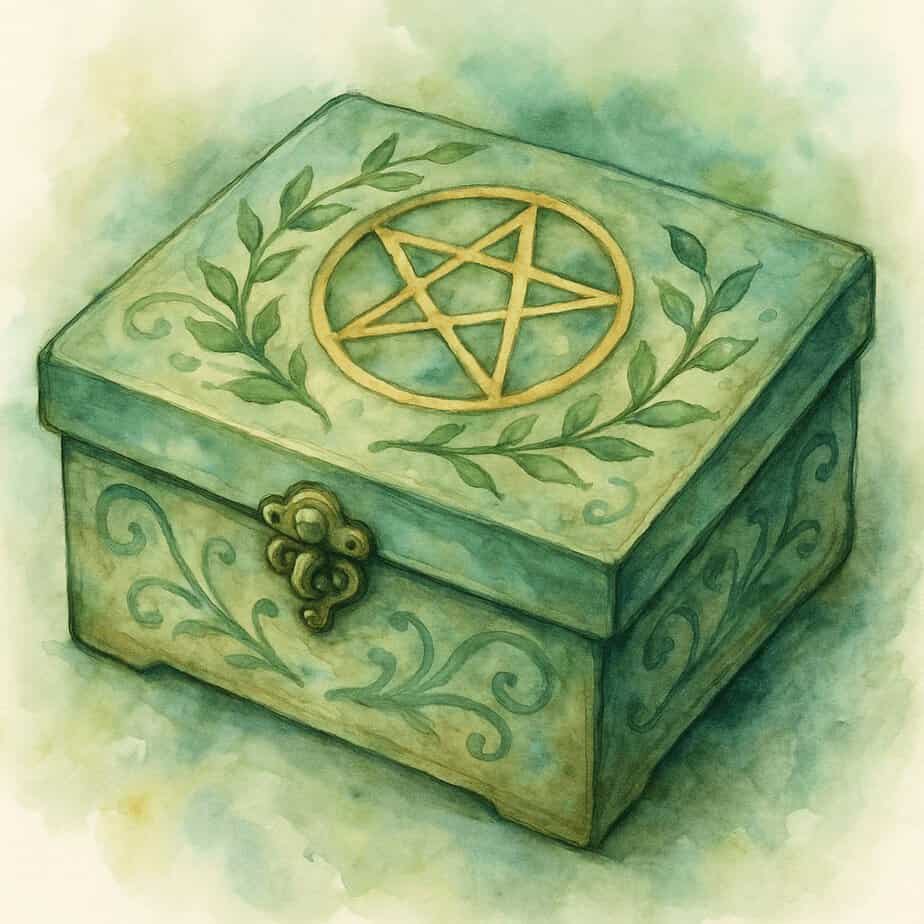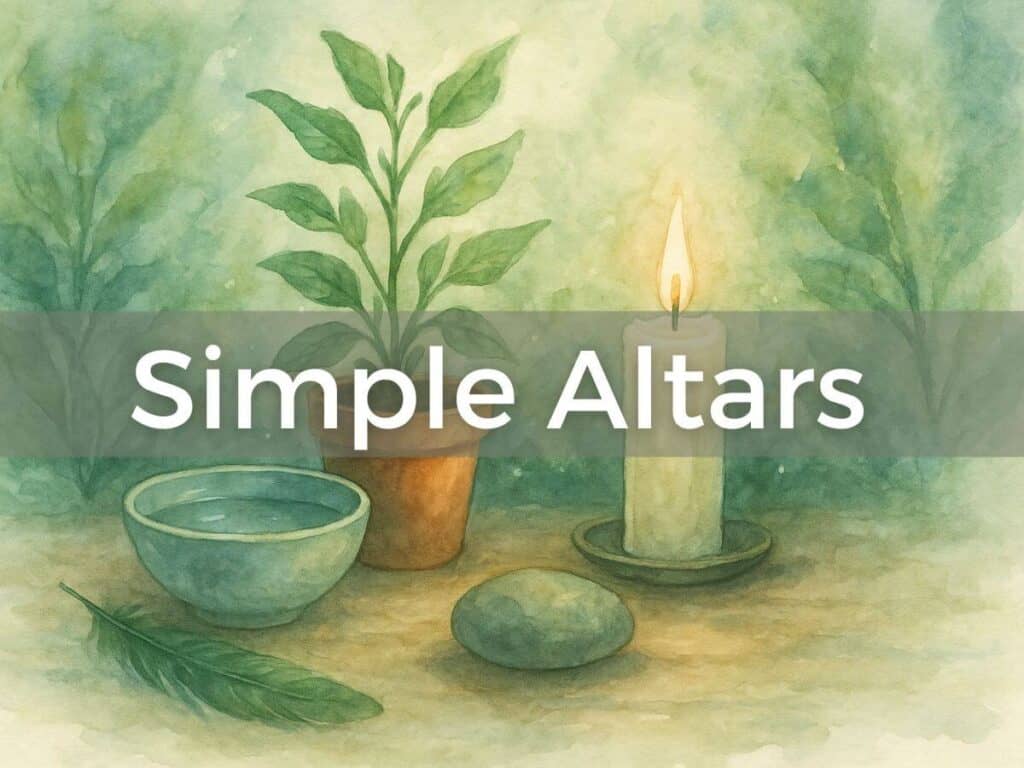Altars are one of the simplest ways to express your connection to your green witch practice. If you’re just starting out with your practice, you might be wondering how to build a simple altar.
Creating your altar can be as simple as placing some found items on a side table or as elaborate as a carefully curated collection with its very own space.
Social media is overflowing with gorgeous altar photos, but your altar’s power comes from meaning, not aesthetics.
This post moves through defining what an altar is, how to choose a spot for yours and how to build one. Because I’m as practical as I am magickal, there’s also some budget friendly tips for you.
Ready?
What is an Altar?
An altar is a place that you’ve dedicated to your personal practice. It’s where you can focus your energy, do spells and rituals, honor what’s important to you and connect with any guides or deities you work with.
You might create one that remains exactly the same all year round or you might change it up with the seasons. You might create several, each with a specific purpose or one that is just for a season or reason.
You get to make all the choices about what you do with your altar(s). It should feel good to you and it should help you remember to pause, connect, reflect and live your magick.
Choosing Where to Put Your Altar
Perhaps there’s a sunny corner where you sip tea in the morning, or a quiet spot with an open shelf that feels like it’s meant to be your altar.
Any surface will do. Truly.
Consider what space you have available. If space is tight, perhaps a small tray that you can move around will work for you. Do you need to put it away or can you leave it out?
Use what you have.
A small side table, a desk, the top of your dresser, a single shelf, or a window sill will all do just fine.
Working at your altar regularly is the goal, so choose your location according to the space you have available, and what you’ll actually use.
Essential Altar Elements
This is the fun part. Gathering the items that call to you.
Choose a few simple items that symbolize each of the four elements. You can also include personal items that are meaningful to you.
Fire: use a candle to represent fire’s illumination. Any type will do. Tealight, pillar, taper, jar or even a birthday candle. Safety is first, so if need be, use an electronic candle.
Water: a bowl or cup of water to symbolize intuition and emotion.
Earth: Select a green potted plant, a favorite crystal or a rock you found in your yard to represent grounding and stability.
Air: Use a feather or incense to symbolize breath and clarity.
A personal item might be an image, a piece of jewelry or any item that is meaningful to you.
These five items and your intention are all you need to build a simple altar.
Of course, you can also add in additional items like altar cloths or statues of any deity you like working with.
Over time, your altar will evolve and grow with you. It’s fine to begin with just the basics.
“Here we are thirty years later and I still use these items because they have traveled this beautiful path with me all these years. They’re less like tools now and more like companions”. – Karen on the repurposed items she still uses to this day.
These Tools Became Part of My Story
When I first started my journey with witchery, I was a young single mother with a limited budget to spend on myself. So I repurposed a white-handled knife from my kitchen into my boline and a second knife became my athame. Small dessert dishes were for holding salt or water and I hand-drew a pentacle. Here we are thirty years later and I still use these items because they have traveled this beautiful path with me all these years. They’re less like tools now and more like companions.
Budget-Friendly Repurposing to Build a Simple Altar
Everyday household objects like these can be repurposed for your altar.
- Bowls from your kitchen
- A stone from your yard or garden
- Candles you have on hand
- Feathers
- Any notebook you already have can become your magickal journal
- Jewelry, seashells, family mementos or trinkets that are meaningful to you can be used on your altar.
- Vintage doilies, embroidered dresser scarves, or even fabric from favorite clothing can be repurposed into altar cloths
Symbolism is what matters, not what you paid for it.
Letting Your Altar Evolve
I mentioned above that your altar will evolve as your practice grows. Allow this to happen. You might begin adding seasonal items like colored leaves in the fall or fresh flowers in the spring.
You might use different crystals that match the moon phase like dark-colored stones at new moon and quartz for full moon or you might add symbols for each sabbat.
You might decide that a minimalist approach is perfect for you.
You are always free to change it.
Remember that it should inspire you. If it doesn’t, then it’s time to do something different.
Privacy and Your Altars
For some witches, privacy is a concern. If you don’t want your roommates or relatives asking questions about your altar, you can create one that is private and meant just for you.
Here’s a bit of inspiration to build a simple altar of your own:
- Build a simple altar using a shoebox or a box you’ve specially decorated to hold your essentials. It can easily be stashed under a bed.
- An empty Altoid tin makes a great travel or mini-altar. There’s enough room to hold a candle, small stone and a special item.
- Keep your magickal journal and a single candle in a drawer so they’re easy to access.
- Put a potted plant on your windowsill and let it do double duty as your altar and an air purifier.
- Jewelry or talismans that you wear as portable sacred items.
None of these are any less powerful than the type that are always on display.

Caring for Your Altar
Taking care of your altar is based in reverence. Clean your items and refresh it when needed. Keep this space feeling sacred and intentional. Giving it a wipe down before using it is a way to reset the energies.
You don’t want your altar to feel like clutter.
If it does, then clear everything away, give it a good cleaning and rebuild it fresh.
Here’s a few things you might not know:
- Bigger altars are not more powerful than smaller ones. The power comes from your intention. Not from the size of the altar.
- Expensive tools aren’t needed. There’s no magickal difference between a glass bowl purchased at a thrift store and one that costs $50. The magick doesn’t come from the price tag.
- Altars do not need to be permanent. You can set one up on a tray, inside a box or Altoid tin and that’s every bit as valid as one that is permanent. How you use it is what matters.
A Beginner-Friendly Altar Setup
Try this to build a simple altar:
Choose your surface ( like a shelf, dresser, tray).
Place one candle in the center to represent fire.
Add a bowl of water, a stone or plant, for earth and a feather or incense for air
Include one personal item such as jewelry, a photo, or a memento
Light the candle and claim your space: “This space is sacred, this space is mine.”
That’s all there is to creating your altar. Of course, as noted above, you can add additional things to your altar based on your intentions, the seasons or what feels right to you.
Bringing It All Together
Being a witch isn’t about stuff.
You can build a simple altar with what you have on hand. Your altar could be a candle, a cup of water, and a notebook on your windowsill.
That’s valid and valuable.
Start with what you have, add what feels meaningful, and let it grow with you. That’s how you build an altar that works for you.
A flickering flame, a small stone, and your whisper of intention are the very essence of magick.
🪄Here’s to creating a little everyday magick as you build a simple altar for your practices.
Blessed be.
Love what you’re reading? Let’s stay connected.
When you join my list, you’ll get new blog posts, seasonal witchcraft tips, and free resources to help you live your craft with joy and intention.
Plus, you’ll get 5 Nature Rituals to help you reconnect to Mother Earth.
Subscribe today and make your practice part of your everyday rhythm.
You Might Like These Too:
Printables for Your Witchy Life – choose from Shadow Work, Moon Journals, Nature Connection + More



